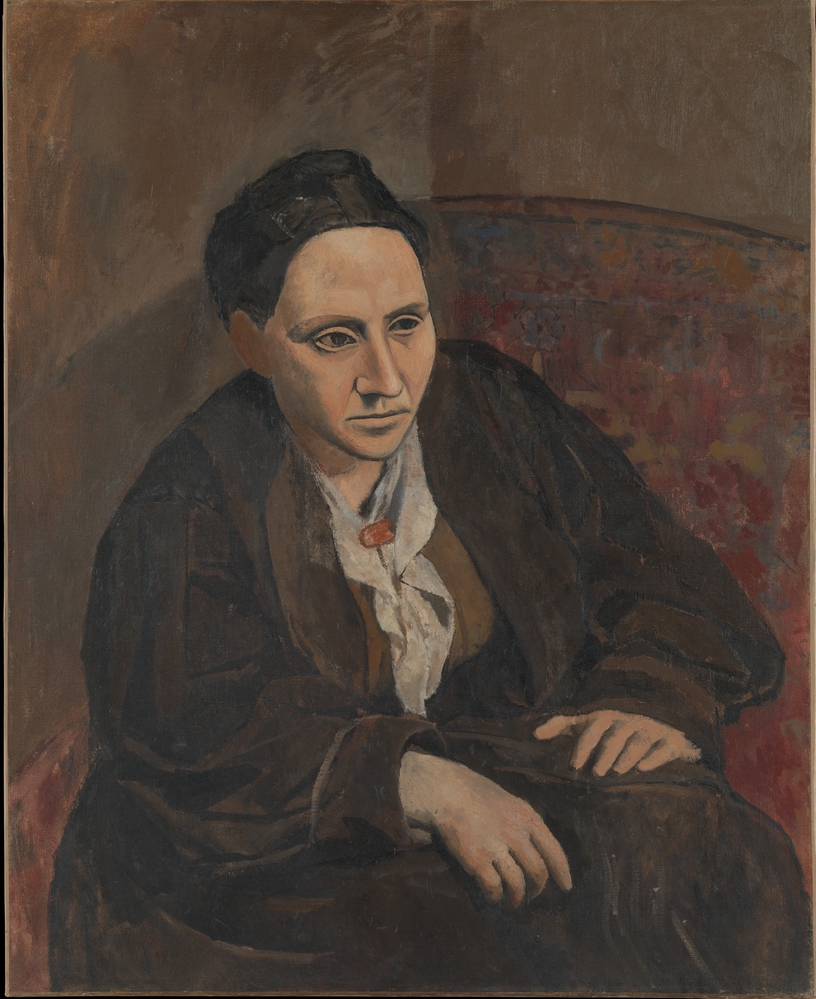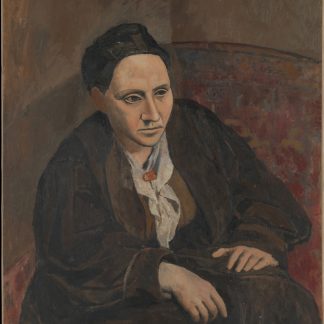Portrait of Gertrude Stein (Portrait de Gertrude Stein)
From $28.69
Product Options:
Giclee Print – Paper:
Giclee print on premium archival quality Fine Art Matte paper. Certificate of Authenticity included. Shipped rolled and ready to be framed.
Giclee Print – Canvas:
Exhibition quality canvas stretched over wooden stretcher bars w/mirrored edge so none of the original image is lost. Certificate of Authenticity included. Ready to hang on your wall.
Giclee Print – Framed:
Giclee print on premium archival quality Fine Art Matte paper with selected frame, single white mat & acrylic front. Certificate of Authenticity included.
Description
At first glance, “Portrait of Gertrude Stein” may appear puzzling or even repulsive to some viewers. Stein’s face, with its prominent forehead, flat nose, and thick lips, seems almost mask-like, lacking the nuances of individual expression or character. Her body is reduced to a series of angular planes and curves, with the chair blending into her clothes and the background, creating a sense of spatial ambiguity. The colors, mainly shades of brown, gray, and green, are subdued and earthy, lacking the vividness or brightness associated with beauty or joy.
However, upon closer inspection, the painting reveals its underlying structure and meaning. Picasso’s cubist technique involves breaking down the subject into multiple perspectives and planes, emphasizing their flatness and two-dimensionality. Stein’s face is composed of geometric shapes, such as triangles, circles, and rectangles, that create a sense of symmetry and balance. Her eyes, despite their abstractness, convey a sense of intelligence, wit, and authority, matching Stein’s persona as a writer and cultural figure.
Furthermore, Stein’s posture and gesture convey a sense of confidence and comfort. She sits upright, with her hands resting on the armrests, as if asserting her presence and control over the space. The chair, a prominent feature in the painting, resembles a throne or a symbol of power, suggesting Stein’s status and influence. The background, a blurry mix of wallpaper patterns and curtains, adds to the sense of depth and movement, as if the painting is not a static representation but a dynamic interpretation of the sitter and her surroundings.
One interpretation of “Portrait of Gertrude Stein” is that it reflects the artistic and intellectual milieu of the time. Stein was a leading figure in the avant-garde scene, hosting salons and gatherings that brought together artists, writers, and thinkers. Picasso, as a young artist, was part of this circle, and his portrait of Stein can be seen as a tribute to her role as a patron of the arts and a promoter of innovation and experimentation. The cubist style, with its emphasis on abstraction, fragmentation, and multiplicity, was a radical departure from the academic conventions of realism and naturalism, and Stein’s portrait embodies this spirit of modernism and rebellion.
Another interpretation of “Portrait of Gertrude Stein” is that it challenges the traditional gender roles and norms of representation. Stein, as a woman and a lesbian, defied the social expectations and conventions of her time, and her portrait can be seen as a celebration of her nonconformity and autonomy. Picasso’s approach to her image, with its rejection of conventional beauty and idealization, can be seen as a rejection of the male gaze and its objectification of women. Instead, Stein’s portrait emphasizes her individuality, her intellect, and her authority, and invites the viewer to look beyond the surface and into the complexity of her personality.
In conclusion, “Portrait of Gertrude Stein” is a significant work of art that challenges the viewer’s expectations and assumptions about portraiture, representation, and gender. Its cubist style, with its fragmentation and abstraction, invites multiple interpretations and readings, reflecting the richness and diversity of modernism. Stein’s portrait is not a mere likeness or a flattering image, but a complex and layered representation





